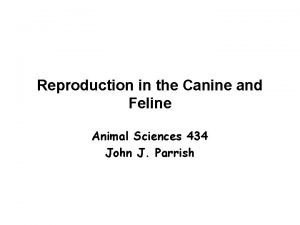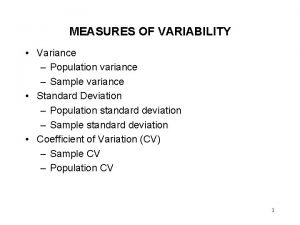Evolution of variance in mate choice Deena Schmidt












- Slides: 12

Evolution of variance in mate choice Deena Schmidt MBI Postdoctoral Fellow July 31, 2009 dschmidt@mbi. osu. edu

Definition of Mate Choice Process where members of one sex mate nonrandomly with respect to one or more varying traits in members of the other sex. Typically, female choice of male mate How and why mate choice evolves has been vigorously debated in the field of evolutionary biology.

Definition of Lek A gathering of males of a certain species for the purpose of competitive mating display. Females visit the lek and choose a mate. Common in fish, birds, and insects Lekking is a model system for understanding sexual selection and the benefits of group living. Lekking males are thought to face strong directional selection on secondary sexual traits.

Diagram of a Lek

“Lek Paradox” The maintenance of variation in the face of strong directional selection on a trait is a general problem in evolutionary biology. Lek paradox: maintenance of variation in female mate choice and male quality on leks. Paradoxical because variation in male traits should decrease rapidly due to selection imposed by female choice.

Influence of “Enemies” on Leks Enemies = predators, egg predators, brood parasites (or sneaker males) Enemies congregate around higher quality males. Females must then trade-off the benefits of mating with high quality males against the increased risk of enemies. Interaction with enemies fitness cost to both females and males

Game Theoretic Model 3 classes of individuals: Males are ranked according to quality: Females, and enemies i. e. high or low Basic assumptions: All females rank males the same way. Ranking is based on some trait that is a measure of quality (“good genes”). In absence of enemies, females choose high quality males.

Game Theoretic Model Focus on the game between females and enemies. Use this model to predict how interactions between females and enemies influence the frequency of high and low quality males. Main idea: Avoidance of costly enemies can lead to variation in female mate choice. This can result in maintenance of variation in male quality.

Game Theoretic Model Main Reference: Hamilton, I. M. et al. Behav. Ecol. 17: 97 -107 (2006). Studied the influence of the female-enemy game on the maintenance of variation in male quality. Project: We will be extending this model.

Possible Extensions to the Model In this model, males do not make decisions. Add male strategies: Invest in safety, defend against enemies Males might reject some females: Consider female vs. male game (instead of female vs. enemy game) Add differences in female quality. Add continuous variation in qualities. Something else you might come up with!

Math Involved Evolutionary game theory model Model interactions within a population: females choosing a mate in the presence of enemies Main parameter = fitness (or payoff) Replicator dynamics Identify evolutionary stable strategies (ESS) Matlab code – run simulations

References Hamilton, I. M. et al. 2006. Predators, reproductive parasites, and the persistence of poor males on leks. Behav. Ecol. 17: 97 -107. Kokko, H. et al. 2003. The evolution of mate choice and mating biases. Proc. R. Soc. Lond. B 270: 653664. (review article) Alonzo, S. H. and Warner, R. R. 1999. Behav. Ecol. 10: 105 -111. Alonzo, S. H. and Warner, R. R. 2000. Behav. Ecol. 11: 56 -70.






















